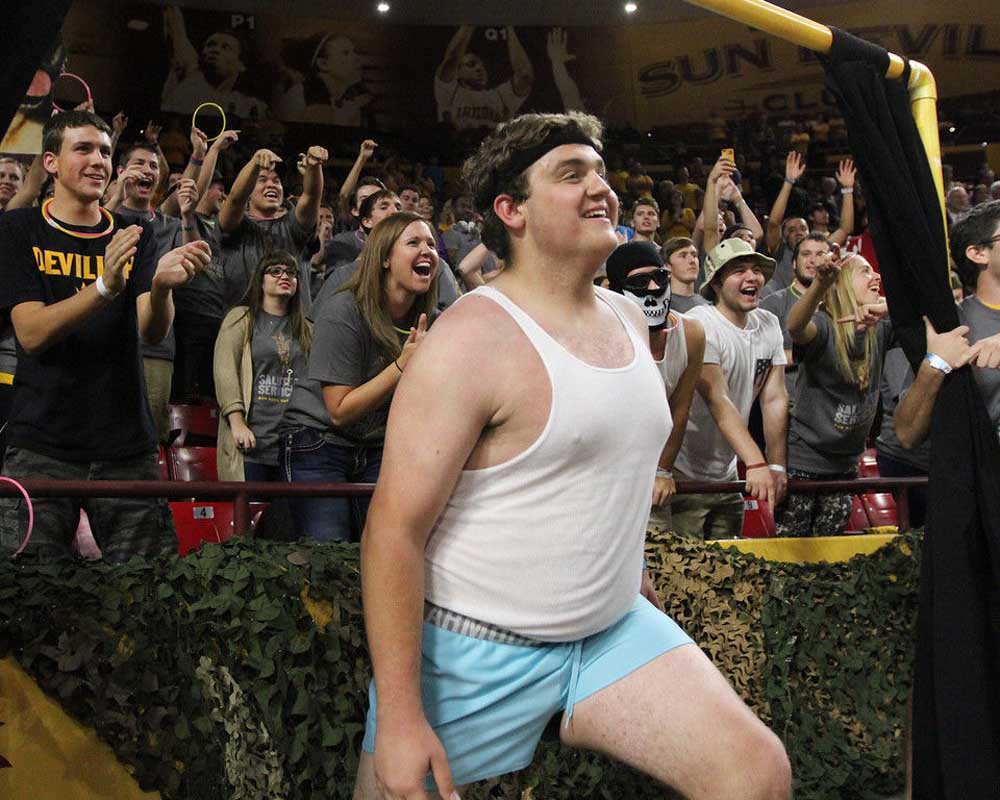Arizona State fans’ antics are absurd; idea that they influence the game is not
Published 12:00 am Monday, February 16, 2015

- Arizona State University athletics / Submitted photosA fan dressed up as a large bird tries to distract the free-throw shooter on an opposing team during a recent game in Tempe, Arizona. Arizona State fans in the student section have been hiding behind a curtain before opening it to display something absurd in an attempt to throw off the free-throw shooters of opposing teams.
A shark attack. The return of Elvis. Twerking farm animals. A shirtless guitarist. Kissing unicorns. An old lady yelling at you to get off her lawn. Distracted yet? So, too, are college basketball players, who have tried — and often failed — to overcome the creative attempts of students at Arizona State to destroy the focus of free-throw shooters.
Of course, student sections that try to throw opponents off their game have been around for decades. But Arizona State’s Curtain of Distraction has taken those attempts to a new level. Just as a visiting player is about to shoot a free throw, two students pull apart two big black curtains to reveal a new five-second act in a continuing theater of the absurd.
The most striking aspect of the routine, though, isn’t any of the bizarre characters. It’s the result. A statistical analysis — with an assist from Nick Wan, who runs the True Brain blog — suggests that the Curtain really works.
It appears to give Arizona State an additional one- to two-point advantage per home game, beyond the normal home-court advantage. The Curtain may even have played the pivotal role in the Sun Devils’ recent upset of in-state rival Arizona.
The easiest way to see the effect is to compare visitors’ free-throw shooting percentage before and after the Curtain’s 2013 introduction. In each of the three seasons from 2010-11 to 2012-13, visitors missed 28 to 32 percent of their free throws. Last season, the Curtain’s first, the rate at which visitors missed free throws rose sharply, to 40 percent.
In the first 14 home games of this season — when the Curtain and its surprises have continued to appear — visitors have missed 36 percent of all free throws. If you didn’t know better, you might suspect that the size of the hoop had gotten smaller.
Given the timing, and the fact that players are powerless to defend a free throw, it seems reasonable to attribute this sharp change to the student high jinks, rather than any change of players or strategy. In fact, the statistics largely rule out competing explanations.
For instance, the free-throw percentage of Arizona State’s opponents has not changed in their other away games, suggesting that the ability of the opponents didn’t change, just their performance when visiting Wells Fargo Arena in Tempe.
And conditions in the arena do not seem to have changed in a way that has made it harder for everyone to hit free throws — just the visiting team. Arizona State has maintained its pre-Curtain levels of accuracy, which makes sense given that the student cheering section puts away the Curtain when the home team is shooting.
Moreover, the accuracy of visiting teams when shooting from the field has remained largely unchanged, which also makes sense, given that the Curtain appears only for free throws.
Taken together, the data suggest that something changed to affect the accuracy only of free throws, only by visiting teams, only when those teams were visiting Arizona State and only after the Curtain of Distraction was introduced. Statistics can never fully prove a causal link, but this case is pretty strong.
The practice of trying to distract visiting players during free throws has a rich history. At the 1960 Olympics in Rome, fans “hooted and whistled at every Soviet player who stepped to the foul line, attempting to distract the player,” according to a New York Times article at the time. In 1978, none other than Pearl Bailey — the actress and singer who had enrolled at Georgetown in her 60s — sat behind the basket during one game, waving her arms to distract Holy Cross shooters.
Students have held up arrows, to nudge the shooter’s attention in one direction. They have borrowed from neuroscience research and swayed their hands to make the basket seem as if it were moving. They have held up enormous photos of celebrities’ heads.
But the 942 Crew — as Arizona State’s band of pranksters is known, in honor of the number of seats in the student section at Wells Fargo Arena — simply appear to be better at distraction than fans elsewhere. Nearly every team that has had to face the Curtain has missed a greater share of its free throws than it has in other road games.
The large differences are all the more remarkable given that the Curtain operates only for the second half of each game, when the visiting team is shooting toward the student section. This timing was critical to the inspiration for the Curtain.
Alexandria Arroyo, an Arizona State nursing student who plays the cranky old lady, explained that she and her fellow students felt called to action when they looked at the statistics on free-throw percentage by half. “In the 2012-2013 season, our opponents had a higher free-throw percentage shooting into our student section than when they weren’t,” she said. “We felt that this was a stat that we could and needed to change.” They evidently succeeded. Since the Curtain’s invention, visiting teams have seen their second-half free-throw percentage fall from 75 percent in 2012-13 to 60 percent.
Overall, analysis suggests that the Curtain of Distraction has led visiting teams to miss an additional 5 to 10 percent of all free-throw attempts. The overall improvement in Arizona State’s free-throw defense — if it even makes sense to speak of defending a free throw — is large enough that it is very unlikely to simply reflect chance.
Given that a typical game includes nearly 20 free throws, this amounts to an advantage of around 1 to 2 points per game, although it may be worth a bit more or less, depending on the game and how distractible the players are. One or 2 points is enough to matter.
On Feb. 7, the unranked Sun Devils beat Arizona, 81-78. This wasn’t just a rivalry win; it was also one of the season’s biggest upsets, with the Sun Devils, 11-11 coming in, beating the No. 6 team in the country. The crowd’s antics may have been the key to the game: The Wildcats missed four free throws in the second half when shooting toward the Curtain.
To some extent, the large effect is surprising. After all, elite athletes are trained to tune out distractions. But tuning out predictable background noise is one thing; what the Curtain adds — an element of surprise, and even delight — is altogether another. Who could resist sneaking a glance to see what the next comedic interlude might be?
As Arroyo said, “It’s the best feeling to see the player at the free-throw line smile after a missed shot.”






